- Synchronized packet losses among different (TCP) flows
- Application level solution:
- Each computer runs an
application program
- Different applications
must become aware
that they have
a common bottle neck router
- Solution requires
distributed awareness
Solution at the application level is not practical...
- Each computer runs an
application program
- Transport level solution:
- Each computer contains a
TCP module
- Different TCP modules must
must become aware
that they have
a common bottle neck router
- Solution requires
distributed awareness
Solution at the application level is not practical...
- Each computer contains a
TCP module
- Network (IP) level solution:
- Each router contains
a IP module
- Synchronized TCP flows
is caused by
synchronized packet drops
from different flows
- The solution is to prevent or reduce the likelihood that packets from different flows are dropped synchronized
- Each router contains
a IP module
- $64,000 question:
- How to prevent routers from synchronized packet drops from different flows during congestion.
- The general
Early Random Detection method:
- specify a dropping policy
- does not provide details on how to implement the policy
- specify a dropping policy
- Overview general RED:

General RED algorithm:
compute average queue length; if ( avg. queue length < minthreshold ) { admit new packet to output queue; } else ( minthreshold < avg. queue length < maxthreshold ) { mark new packet with probability Prob(queue length); } else { always mark new packet; } - The RED algorithm
can be found on Page 7 of the paper
"Random Early Detection Gateways
for Congestion Avoidance"
- The general RED algorithm
leaves the following
questions open
(i.e., undefined):
- How do you compute the
average queue length ?
- How do you calculate the drop probability Prob(queue length) ?
- How do you compute the
average queue length ?
- Ideal implementation of Marking:
- Offending packets are
marked with a
bit
- The markingbit is
returned by
the destination to the
sender
- When the sender receives a marking bit, the sender reduced the CWND
Advantage:
- Packets are not dropped
Disadvantage:
- Modifications are required to
both the
sending
and the
receiving TCP modules
- Also, the
modification must be
made to
all existing TCP software
(Or else, it will not work)
- Offending packets are
marked with a
bit
- Reality:
- Offending packets are
dropped
- A dropped packet will cause TCP (Reno) to reduce its CWND
- Offending packets are
dropped
- Floyd and Jacobson proposed the following methods
to compute:
- average queue length :
use exponetial weighted moving average
- drop probability: this function
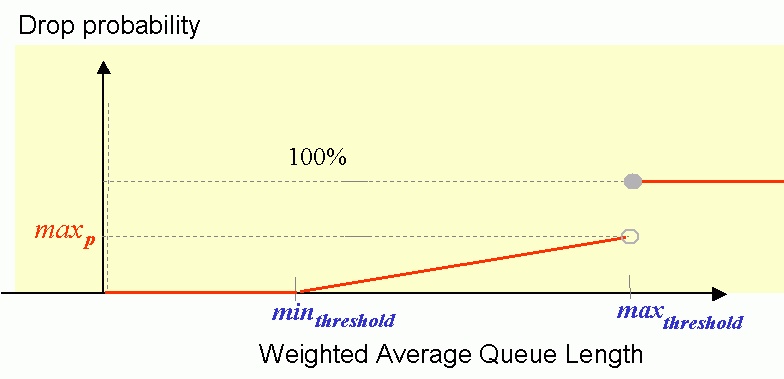
- average queue length :
use exponetial weighted moving average
- Exponential weighted moving average:
weights newer values
more heavily,
old values
weighted exponetially less
- Input numbers:
- q1, q2, q3, ....
- Weight:
- w
- Exponential weighted moving averages:
- average of (q1): w × q1
- average of (q1, q2): (1 − w) × w × q1 + w × q2
- average of (q1, q2, q3): (1 − w)2 × w × q1 + (1 − w) × w × q2 + w × q3
- average of (q1, q2, q3, q4): (1 − w)3 × w × q1 + (1 − w)2 × w × q2 + (1 − w) × w × q3 + w × q4
- Input numbers:
- Computing Exponentially weighted moving average:
Meaning of the variables: curr_time = current time q_idle_time = the time when the queue last became empty wq = weight (a constant between 0 and 1)
q = current queue length; if ( q > 0 ) { avg = ( 1 - wq ) * avg + wq * q; // Compute moving average } else { // Idle !!! x = f( curr_time - q_idle_time ); avg = (1 - wq)x * avg; // Because: wq * q = 0 // Note: weight is increased // if interval x is larger q_idle_time = curr_time; // Paper has a bug }Notes:
- The statement
- avg = ( 1 - wq ) avg + wq * q
can compute exponetial decay for older terms
Example: Suppose avg = 0 and the first 3 queue length measures are q1, q2, and q3
Initially: avg = 0
First queue length measure: q1 avg = ( 1 - wq ) avg + wq * q1 avg = wq * q1
Second queue length measure: q2 avg = ( 1 - wq ) avg + wq * q2 avg = ( 1 - wq ) wq * q1 + wq * q2
Third queue length measure: q3 avg = ( 1 - wq ) avg + wq * q3 avg = ( 1 - wq ) [ ( 1 - wq ) wq * q1 + wq * q2 ] + wq * q3 avg = ( 1 - wq )2 wq * q1 + ( 1 - wq ) wq * q2 + wq * q3 - The statement
- The following graph
shows the relationship
between the
current queue length
(the darkblue plot)
and the
exponential weighted
average queue length (the red plot):

- The average queue length is more smoother than the current (instantaneous) queue length
- The drop probability
Prob(queue length)
increases
linearly
from
0 ... maxp
between queue length values
minthreshold
... maxthreshold:

- marking (drop) algorithm:
count = number of UNMARKED packets since the last marked packet
if ( avg < minthreshold ) { admit new packet; } else if ( minthreshold < avg < maxthreshold ) { /* ------------------------------------------ Compute drop probability (linear) ------------------------------------------ */ avg - minthreshold pb = --------------------------- * maxp maxthreshold - minthreshold /* ---------------------------------------------------- Adjust drop probab. when there are no drops ---------------------------------------------------- */ count++; // # times that RED fails to drop a packet pb pa = --------------- // pa increases when count increases 1 - pb * count /* ------------------------------------------ Drop packet with probab pa ------------------------------------------ */ if ( random() < pa ) { Mark arriving packet count = 0; // Reset count... reduce adjusted drop probability pa } } else if ( avg > maxthreshold ) { Mark arriving packet count = 0; }
- The RED queue management
algorithm is implemented in NS2 as the class
REDQueue :
click here
The RED drop code is found around line 508 in the file red.cc
- The paper
"Random Early Detection Gateways for Congestion Avoidance"
presented a simulation study of the RED algorithm.
- Simulation network used:
- Node 1 begins to transmit at time 0.0 sec
- Node 2 begins to transmit at time 0.2 sec
- Node 3 begins to transmit at time 0.4 sec
- Node 4 begins to transmit at time 0.6 sec
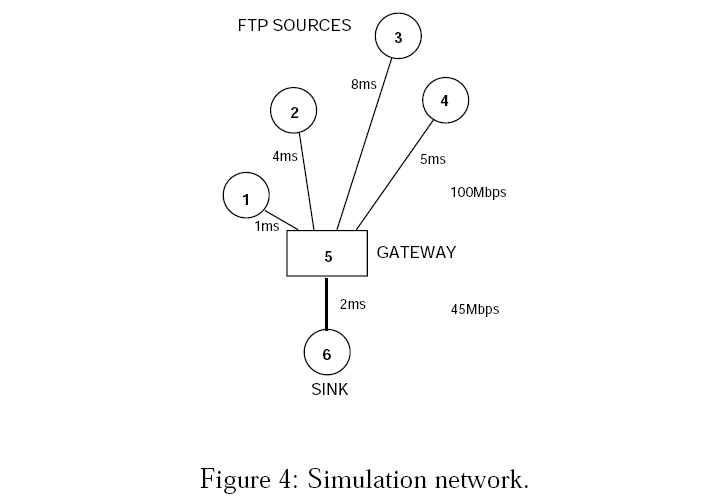
- Average Queue Size in congested router:
- The instantaneous queue size is given by the jagged line
- The average queue size is given by the smooth line
- The weight parameter
wq = 0.002
- The parameters
minthreshold = 5 packets
and
minthreshold = 15 packets
They are given by the 2 dotted lines in the figure - The parameters maxp = 1/50 (0.02)
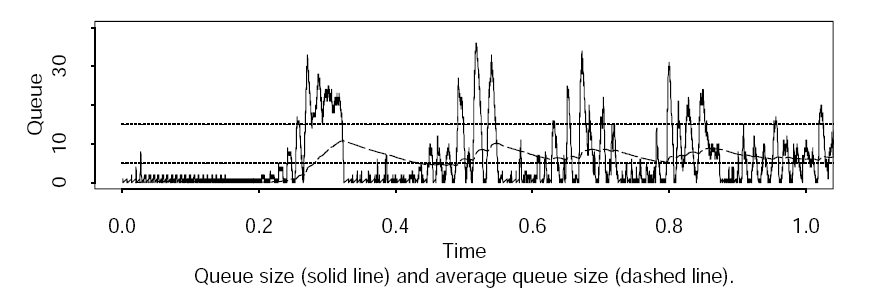
- Results of the simulation:
- NO synchronized packet drops among the flows.
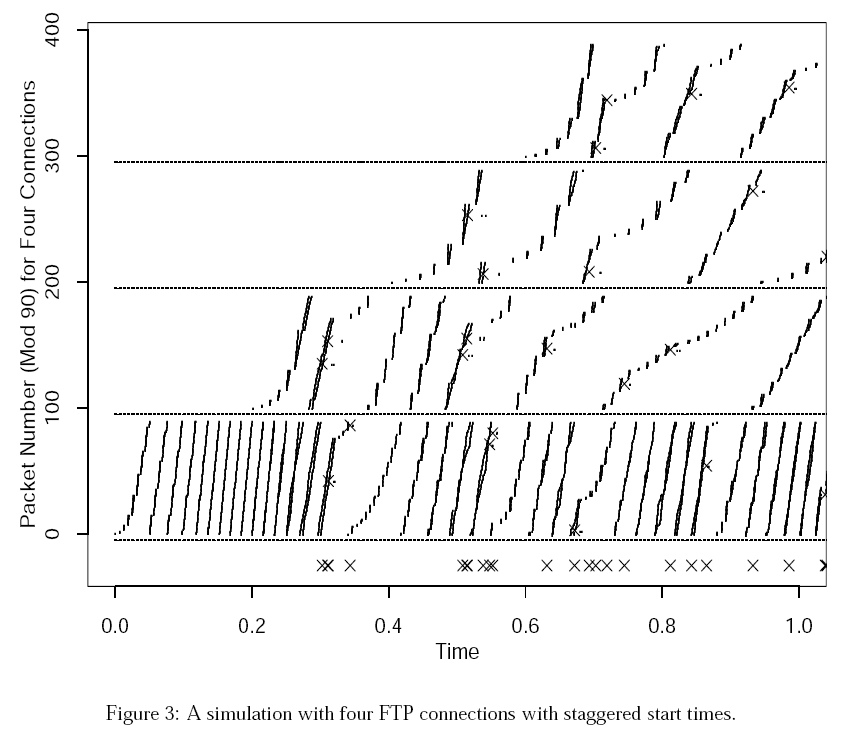
- The following simulation study shows that
the RED queue management can achive
higher throughput
than Drop Tail
- The simulation scenario:

- The throughput vs. queue length in RED and Drop Tail:
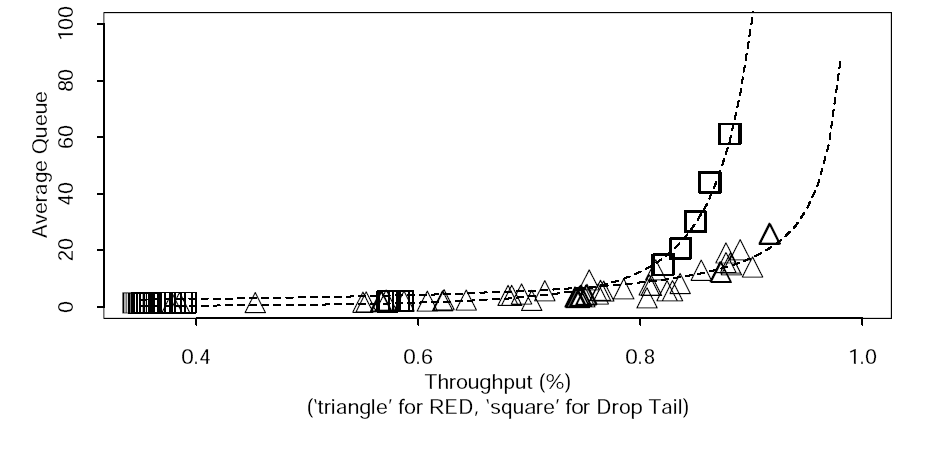
- The authors attribute the
improved throughput
to the
reduced average queue length
- Packets wait less time in the queue and get out faster.
(Analogy: keep the car on the high way moving and you can get more cars through. Longer lines not only slows the traffic, in fact, a lower number of car per time unit will get through to the destination)
- There are 4 important parameters
in RED:
- minthreshold
- maxthreshold
- maxp
- wq
- RED
is
exceptionally sensitive
to the
setting of its parameters
- It is very hard to tell which values are right for
a particular case... (sort of trial and error if
you don't practice black magic...)
- The following guides are suggested in picking the
following RED parameters:
- maxthreshold
= 3 * minthreshold
- maxp = 0.1
- maxthreshold
= 3 * minthreshold
- There are no definitive recommendations on how to set
minthreshold
and
wq
- The authors do suggest the following
(rather strange) recommendations:
- minthreshold
= 5 packets ???
- wq = 0.002
- minthreshold
= 5 packets ???
- A RED queue
is defined between nodes
$n1
and
$n2
using the RED
queueing option.
Example:
$ns duplex-link $n1 $n2 10Mb 10ms RED
- The RED queue
has a number of
parameters
that you can set.
The name of the parameters (OTcl instance variables) are:
- thresh_
= minumum threshold
(queue threshold at which
RED begins to mark packets probabilistically)
- maxthresh_
= maximum threshold
(queue threshold
at which RED begins to mark every arriving packets)
- q_weight_
= wq
(factor in the
Exponential Weighted Moving Average)
- linterm_
= 1/maxp
(as average queue size varies between
thresh_ and
maxthresh_,
the packet dropping probability is increased
from 0 to 1/linterm_
- setbit_ =
marking/dropping flag.
If setbit_ = 0 or false, a marked packet is simply marked and not dropped.
If setbit_ = 1 or true, a marked packet is dropped
Examples:
Queue/RED set q_weight_ 0.002 Queue/RED set thresh_ 10 Queue/RED set maxthresh_ 20 Queue/RED set setbit_ true
- thresh_
= minumum threshold
(queue threshold at which
RED begins to mark packets probabilistically)
- DEMO:
(RED vs. DropTail)

- 2 Reno flows in DropTail:
click here
- 2 Reno flows with RED:
click here
Try changing the Min Threshold and Max Threshold.
- 2 Reno flows in DropTail:
click here
- CWND Output from these programs:
DropTail experiment:

RED experiment:
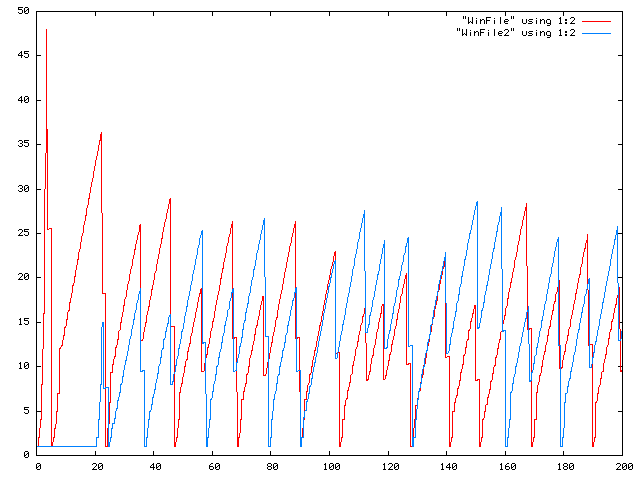
- RED is very controversial...
- Publications like: "Reasons not to deploy RED" (1999)
testify against the use of RED:
click here
Setting the parameters in RED is more like Black Magic than anything else...
And this is supposed to work in a WORD WIDE Internet - not gonna happen.